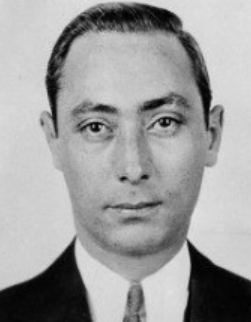a Luciano, a Capone, or a Gambino. But if you trace the bloodlines of mob violence and the shady tendrils of America’s gambling underworld, his name keeps surfacing like a bad memory. Frost was a hustler, a gambler, and a mob-connected opportunist whose career mirrored the dirty, restless growth of organized crime in America from Prohibition to Nevada’s casino boom.
He lived in the shadows of bigger men, but he was always close enough to the action that his fingerprints ended up on some of the most notorious mob-connected crimes of the mid-20th century.
The Early Chicago Years: A Gunman Among Wolves
Born in 1898, Frost came of age in Chicago at the worst possible time—or maybe the best, depending on how you look at it. The city was a boiling pot of rival gangs when Prohibition hit. The North Side and South Side outfits were butchering each other over bootlegging routes, and young men who could handle themselves with a gun had no trouble finding work.
Frost ran with the Aiello-Moran gang, a violent crew that made its mark in Chicago’s bloody Prohibition wars. He hid behind a carousel of aliases—Eddie Ryan, Frank Bruna, Frank Citro—like a man changing masks before every act. Frost had a reputation for being slippery, someone you couldn’t pin down. That would become a theme for the rest of his life.
In November 1928, a union leader named John G. Clay was mowed down with a machine gun in Chicago. Frost was the prime suspect. The killing had all the hallmarks of mob business—labor racketeering, union muscle, and the settling of old scores. Frost wasn’t convicted, but everyone in Chicago’s underworld knew his name after that night.
St. Valentine’s Day and a New Allegiance
A few months later, on February 14, 1929, seven men from Bugs Moran’s North Side gang were lined up against a wall and massacred with Tommy guns. The St. Valentine’s Day Massacre became one of the most infamous mob killings in history. For a brief moment, authorities thought Frost was among the dead.
He wasn’t. Instead, he used the chaos to switch sides. Frost cut ties with Moran’s people and drifted into Al Capone’s orbit. That move said everything about his nature—he wasn’t loyal, he wasn’t built for honor among thieves. He was built for survival, and survival meant staying close to whoever held the most power at the time.
The Murder of a Reporter
In June 1930, a Chicago Tribune crime reporter named Alfred “Jake” Lingle was gunned down in broad daylight at the Illinois Central Railroad station. Lingle wasn’t just a journalist; he was a fixer, a man who knew the mob and worked both sides of the street. His murder shocked the city and embarrassed the Chicago Outfit.
When police traced the murder weapon, it led them straight to Frank Frost. The gun that killed Lingle had passed through his hands. He was indicted as an accessory after the fact. Prosecutors believed Frost knew who ordered the hit and how it was carried out, but he played dumb. Leo V. Brothers, a known mob enforcer, eventually took the fall as the triggerman, but the stink of Lingle’s murder followed Frost for the rest of his life.
This was Frost’s world: never the man pulling the trigger in the history books, but always standing in the corner of the crime scene, smirking, waiting for the smoke to clear.
L.A. and the Long Shadow of the Outfit
With the heat on in Chicago, Frost skipped town. He surfaced in Los Angeles under yet another alias—Frank Foreman. The Outfit was expanding west, pushing into Hollywood and laying down roots in gambling operations. Frost was there to grease the wheels, shake down marks, and keep the machine humming.
He never stayed out of trouble. He was picked up on charges tied to extortion schemes, linked to mobsters who tried to squeeze money out of widows and businessmen. He dodged most of the charges, but he picked up a conviction for carrying a concealed weapon. It was a slap on the wrist, but it was enough to remind everyone that Frost wasn’t just some drifting gambler—he was a gangster with serious ties.
Reno: The Gambler in the Desert
By the mid-1930s, Nevada had legalized gambling. For mobsters, Reno and Las Vegas were the new frontier—a chance to turn criminal rackets into something that looked legitimate. Frost moved into Reno like a man chasing his last big score.
He wasn’t alone. He linked up with William “Curly” Graham and James “Cinch” McKay, mob-connected bankers who were financing gambling clubs. Frost became part of the Reno Turf Club, a hotspot that drew in money and shady characters in equal measure. For a while, it looked like Frost had finally found his niche—running cards, pulling strings, and operating in the smoky backrooms of Nevada gambling halls.
But Reno wasn’t free of oversight. Nevada regulators eventually blacklisted Frost from the gambling industry. Too many arrests, too many mob ties, too much baggage. The state was happy to take the mob’s money, but men like Frost were a liability.
The Hitman’s Whisper
One story about Frost refuses to die. Mob sources later claimed that Frost was involved in arranging—or maybe carrying out—the murder of gambler Mert Wertheimer. Wertheimer had crossed powerful men, and according to whispers, Curly Graham wanted him gone. Frost, ever the survivor, was said to be the man who made it happen.
The truth is buried in rumor and mob folklore, but the fact that Frost’s name comes up at all tells you everything you need to know. He was trusted to get things done. Dirty things. Bloody things.
A Fade into Shadows
By the 1950s, Frost was no longer a central figure in the mob’s operations. He drifted into small-time business ventures—leasing sawmills, dabbling in car dealerships, filing lawsuits, hustling wherever he could. He was still a gambler, still a hustler, but the big scores had passed him by.
He lived out his last years in Reno, where the casinos roared and the mob ran the town behind the neon lights. On April 1, 1967, Frank “Frankie” Frost died at the age of 68. There was no blaze of glory, no headlines screaming his name. Just a gambler who had played every angle until the house finally closed him out.
Legacy of a Forgotten Mobster
Frank Frost was never a boss, never a household name, but his story cuts to the heart of how organized crime really worked. Not every gangster ends up immortalized in books and movies. Most lived like Frost—on the fringes, hustling, scheming, always just one step ahead of the law but never powerful enough to write their own legend.
He touched some of the biggest crimes of his era: the bloody labor wars of Chicago, the St. Valentine’s Day fallout, the assassination of a reporter, the rise of Reno’s gambling scene. But Frost’s story is less about power and more about survival. He was a parasite on the mob’s bloodstream, a reminder that behind every famous boss stood a hundred shadows like him—men who did the dirty work, took the falls, and left behind little more than whispers.
In the end, Frank “Frankie” Frost is remembered not because he was great, but because he was there—always there, lurking in the margins of mob history.


